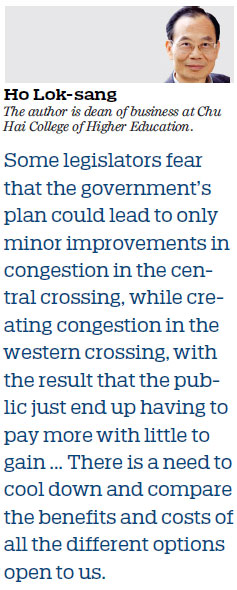Time for rational decision on the tunnel toll reform
Updated: 2019-03-05 07:18
(HK Edition)
|
|||||||
Ho Lok-sang suggests a workable and sensible solution to this contentious issue which will also help to reduce traffic congestion in Hong Kong
Lately, the controversy over the traffic reshuffling among our three cross-harbor tunnels is heating up again. The government keeps insisting that the proposal tabled is the best and cannot be changed. Our political parties, on the other hand, keep insisting that the proposal to double the toll on the central crossing makes the proposal "difficult to accept". Some transport experts, including Hung Wing-tat of the Hong Kong Polytechnic University and Timothy Hau of the University of Hong Kong, side with the government, and ask the public to accept the proposal as tabled, namely doubling the central crossing toll to HK$40 and reducing the western crossing toll from HK$70 to HK$50. Some legislators fear that the government's plan could lead to only minor improvements in congestion in the central crossing, while creating congestion in the western crossing, with the result that the public just end up having to pay more with little to gain.
To better focus on the main issue, we will not talk about the eastern crossing.

The government says that any surplus from raising the tolls on the central and eastern crossings after compensating the western crossing for reducing its tolls will be put aside in a fund reserved for improving traffic management. Legislators say that improving traffic management is on the government's agenda any way under the smart city initiative. So the latest "concession" from the government is just a cover and not a genuine one.
Clearly these heated debates do not help the cause of improving our transport system at all. There is a need to cool down and compare the benefits and costs of all the different options open to us. As far as the government is concerned, there are just two options.
Option 1, the government insists on its "take it or leave it" position.
Option 2, the government takes the counter proposal of legislators and reduces the toll increase so that the central crossing toll would be HK$30 or HK$35.
If the government takes option 1, it is clear that the proposal to reset our cross-harbor tolls will be rejected. We will end up "enjoying" very low cross-harbor tolls for the central crossing and also suffering very heavy congestion. Traffic on the western crossing will be guaranteed smooth, but tolls can shoot up to even higher levels, which will certainly further aggravate congestion on the central crossing.
If the government decides on option 2, traffic congestion in the central crossing will be definitely alleviated relative to option 1, and this relative improvement will almost certainly increase over time. Because the toll on the central crossing will be somewhat lower, it is almost certain that the western crossing will lose some traffic. This means the traffic on the western crossing will be smoother, alleviating the legislators' concerns that all cross-harbor tunnels will be clogged up. At the same time, the western crossing is likely to take in less revenue, thus requiring greater compensation from the government. If an appropriate amount of compensation is paid, there is no reason why option 2 is not acceptable for the western crossing.
To me, option 2 is clearly superior to option 1.
The government of course has its reason to insist on the original proposal. I have had the chance to speak to Professor Hung Wing-tat who also says the government's proposal is best. It seems that the government's position is backed up by technical analysis.
However, as an economist who has done simulation studies before, I know what simulations are all about. Simulations involving human subjects must include behavioral assumptions, which are usually "stylized facts" based on past information. These assumptions are not necessarily correct. Past information about human behavior is grounded on past parameters. When predicting the future, with the parameters changed, taking stylized facts as behavioral assumptions need not always be correct.
Actually, the fact that the proposed tolls are HK$50 on the western crossing, and HK$40 on the central crossing, already suggests that these proposals cannot be precise optimal tolls, which could well be HK$38.5 or HK$41, and HK$53.5 or HK$49. Pretending that the combination of HK$40 and HK$50 are the precise optimal tolls is just untenable.
More important, even if the proposed tolls are truly optimal, how good is it if politically they cannot become a reality?
The real options available to the government are these:
Option 1: Central crossing remains very much congested, and the congestion continues to worsen up to 2023. Meanwhile, the toll on the western crossing will continue to rise.
Option 2: Central crossing will be less congested compared to now and the western crossing will be less congested compared to what would happen under the original new tolls.
It just does not make sense for the government to take option 1.
I should also point out that option 2 does not actually preclude the government from adjusting the toll on the central crossing later. Suppose the new toll for central crossing is HK$30; then if traffic is still too heavy, it can be raised to HK$35 and even to HK$40 after a couple of years.
(HK Edition 03/05/2019 page8)